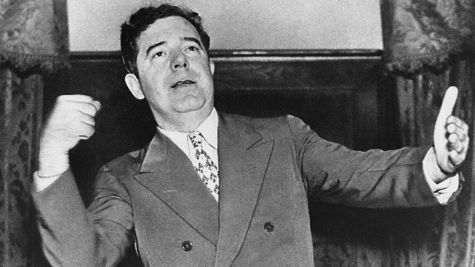


Curated/Reviewed by Matthew A. McIntosh
Public Historian
Brewminate
Introduction
The Senate tradition of unlimited debate has allowed for the use of the filibuster, a loosely defined term for action designed to prolong debate and delay or prevent a vote on a bill, resolution, amendment, or other debatable question. Prior to 1917 the Senate rules did not provide for a way to end debate and force a vote on a measure. That year, the Senate adopted a rule to allow a two-thirds majority to end a filibuster, a procedure known as “cloture.” In 1975 the Senate reduced the number of votes required for cloture from two-thirds of senators voting to three-fifths of all senators duly chosen and sworn, or 60 of the 100-member Senate.
Origin and Use

Whether praised as the protector of political minorities from the tyranny of the majority, or attacked as a tool of partisan obstruction, the right of unlimited debate in the Senate, including the filibuster, has been a key component of the Senate’s unique role in the American political system.
The tactic of using long speeches to delay action on legislation appeared in the very first session of the Senate. On September 22, 1789, Pennsylvania Senator William Maclay wrote in his diary that the “design of the Virginians . . . was to talk away the time, so that we could not get the bill passed.” As the number of filibusters grew in the 19th century, the Senate had no formal process to allow a majority to end debate and force a vote on legislation or nominations.
While there were relatively few examples of the practice before the 1830s, the strategy of “talking a bill to death” was common enough by mid-century to gain a colorful label—the filibuster. Derived from a Dutch word for “freebooter” and the Spanish “filibusteros”—to describe the pirates then raiding Caribbean islands—the term began appearing in American legislative debates in the 1850s. “I saw my friend standing on the other side of the House filibustering,” commented Mississippi’s Albert Brown on January 3, 1853. A month later, North Carolina senator George Badger complained of “filibustering speeches,” and the term became a permanent part of our political lexicon.
The earliest filibusters also led to the first demands for what we now call “cloture,” a method for ending debate and bringing a question to a vote. In 1841 the Democratic minority attempted to run out the clock on a bill to establish a national bank. Frustrated, Whig senator Henry Clay threatened to change Senate rules to limit debate. Clay’s proposal prompted others to warn of even longer filibusters to prevent any change to the rules. “I tell the Senator,” proclaimed a defiant William King of Alabama, “he may make his arrangements at his boarding house for the [entire] winter.” While some senators found filibusters to be objectionable, others exalted the right of unlimited debate as a key tradition of the Senate, vital to tempering the power of political majorities.
Filibusters became more frequent in the late 19th and early 20th centuries, leading to serious debate about changing Senate rules to curtail the practice. At that point the Senate had grown larger and busier, and the sheer amount of work to be done in each session meant that a filibustering senator could disrupt the progress of the body and gain concessions from senators who wanted to get their bills passed.
In 1917, with frustration mounting and at the urging of President Woodrow Wilson, senators adopted a rule (Senate Rule 22) that allowed the Senate to invoke cloture and limit debate with a two-thirds majority vote. This rule was first put to the test in 1919, when the Senate invoked cloture to end a filibuster against the Treaty of Versailles. Even with the new cloture rule, however, filibusters remained an effective means to block legislation, since a two-thirds vote was difficult to obtain. Over the next four decades, the Senate managed to invoke cloture only five times. Filibusters proved to be particularly useful to southern senators who sought to block civil rights legislation, including anti-lynching bills. Not until 1964 did the Senate successfully overcome a filibuster to pass a major civil rights bill. Nevertheless, a growing group of senators continued to be frustrated with the filibuster and pushed to change the cloture threshold. In 1975, the Senate reduced the number of votes required for cloture from two-thirds of senators voting to three-fifths of all senators duly chosen and sworn, or 60 of the current 100 senators. Today, filibusters remain a part of Senate practice, although only on legislation. The Senate adopted new precedents in the 2010s to allow a simple majority to end debate on nominations.
The type of filibuster most familiar to Americans is the marathon speech by a small group of senators, or even a single senator, such as the filibuster staged by fictional senator Jefferson Smith in Frank Capra’s 1939 film Mr. Smith Goes to Washington. There have been some famous filibusters in the real-life Senate as well. In 1917, for example, Wisconsin senator Robert La Follette used the filibuster to demand free speech during wartime. During the 1930s, Senator Huey P. Long effectively used the filibuster against bills that he thought favored the rich over the poor. In the 1950s Oregon senator Wayne Morse famously used the filibuster to educate the public on issues he considered to be of national interest. The record for the longest individual speech goes to South Carolina’s Strom Thurmond, who filibustered for 24 hours and 18 minutes against the Civil Rights Act of 1957.
Historical Highlights
Senate Adopts Cloture Rule (March 8, 1917)

Woodrow Wilson considered himself an expert on Congress—the subject of his 1884 doctoral dissertation. When he became president in 1913, he announced his plans to be a legislator-in-chief and requested that the President’s Room in the Capitol be made ready for his weekly consultations with committee chairmen. For a few months, Wilson kept to that plan. Soon, however, traditional legislative-executive branch antagonisms began to tarnish his optimism. After passing major tariff, trade, and banking legislation in the first two years of his administration, Congress slowed its pace.
By 1915, the Senate had become a breeding ground for filibusters. In the final weeks of the Congress that ended on March 4, one administration measure related to the war in Europe tied the Senate up for 33 days and blocked passage of three major appropriations bills. Two years later, as pressure increased for American entry into that war, a 23-day, end-of-session filibuster against the president’s proposal to arm merchant ships also failed, taking with it much other essential legislation. For the previous 40 years, efforts in the Senate to pass a debate-limiting rule had come to nothing. Now, in the wartime crisis environment, President Wilson lost his patience.
Decades earlier, he had written in his doctoral dissertation, “It is the proper duty of a representative body to look diligently into every affair of government and to talk much about what it sees.” On March 4, 1917, as the 64th Congress expired without completing its work, Wilson held a decidedly different view. Calling the situation unparalleled, he stormed that the “Senate of the United States is the only legislative body in the world which cannot act when its majority is ready for action. A little group of willful men, representing no opinion but their own, have rendered the great government of the United States helpless and contemptible.” The Senate, he demanded, must adopt a cloture rule.
On March 8, 1917, in a specially called session of the 65th Congress, the Senate agreed to a rule that essentially preserved its tradition of unlimited debate. The rule required a two-thirds majority to end debate and permitted each member to speak for an additional hour after that before voting on final passage. Over the next 46 years, the Senate managed to invoke cloture on only five occasions.
Huey Long Filibusters New Deal Legislation

Described as “the most colorful, as well as the most dangerous, man to engage in American politics,” Louisiana’s Huey Pierce Long served in the Senate from 1932 until his assassination less than four years later. Today, visitors to his six-foot, eight-inch bronze likeness in the U.S. Capitol’s Statuary Hall see this master of the Senate filibuster captured in mid-sentence.
Long gave the Senate’s official reporters of debates a Bible because his wife wanted the reporters to “take those supposed quotations you are making from the Bible and fit them into your speeches exactly as they are in the Scripture.” She might also have suggested donating a copy of the U.S. Constitution, for he loved to quote his version of that document as well.
On June 12, 1935, the fiery Louisiana senator began what would become his longest and most dramatic filibuster. His goal was to force the Senate’s Democratic leadership to retain a provision, opposed by President Franklin Roosevelt, requiring Senate confirmation for the National Recovery Administration’s senior employees. His motive was to prevent his political enemies in Louisiana from obtaining lucrative NRA jobs.
Huey Long spoke for 15 hours and 30 minutes, the second-longest Senate filibuster to that time. As day turned to night, he read and analyzed each section of the Constitution, a document he claimed the president’s New Deal programs had transformed to “ancient and forgotten lore.”
Looking around the chamber at several of his colleagues dozing at their desks, the Louisiana populist suggested to Vice President John Nance Garner, who was presiding, that every senator should be forced to listen to him until excused. Garner replied, “That would be unusual cruelty under the Bill of Rights.” Finished with the Constitution, Long asked for suggestions. “I will accommodate any senator on any point on which he needs advice,” he threatened. Although no senator took up his offer, reporters in the press gallery did by sending notes to the floor. When these ran out, Long provided his recipes for fried oysters and potlikker. At four in the morning, he yielded to a call of nature and soon saw his proposal defeated. Two days later, however, he was back, refreshed and ready to fight for a liberalization of a controversial new plan known as the Social Security Act.
“Mr. Smith” Comes to Washington (October 17, 1939)

From a back-row desk on the Democratic side of a crowded Senate Chamber, the idealistic freshman member labored into the 24th hour of a one-man filibuster. His secretary sat in the gallery frantically signaling which rules would keep him from losing the floor. The vice president was in his place and so was every senator. No one moved. Finally the freshman’s leading antagonist, a cynical old-timer, rose to seek a unanimous consent agreement. He asked the Senate’s permission to bring into the Chamber 50,000 telegrams, from all sections of the nation, demanding that the young senator end his futile crusade. Distraught, but vowing to continue his fight against an entrenched political establishment, the exhausted senator then collapsed.
As overturned baskets of telegrams cascaded paper over the junior member’s prone body, the senior senator suddenly changed course. Shaken by what he had just seen, he dramatically confessed to corrupt deeds and demanded that the Senate expel him instead of his idealistic younger colleague. Recognizing the freshman senator’s vindication, the Chamber erupted with joyful shouts as the vice president lamely tried to restore order.
The credits rolled and the lights came on. The audience that packed Washington’s Constitution Hall on October 17, 1939, included 45 real-life senators and 250 House members. They had come to a world premiere of the Columbia Pictures film, Mr. Smith Goes to Washington. The film starred 30-year-old Jimmy Stewart as the noble-minded “Mr. Smith,” Claude Rains as the corrupt-but-redeemed senior senator, and Jean Arthur as Smith’s loyal secretary.
Paramount Pictures and MGM had previously turned down offers to purchase the story, fearing that its unflattering portrayal of the Senate might be interpreted as a “covert attack on the democratic form of government.”
Most of the senators attending the premiere responded with good humor to the Hollywood treatment, with its realistic reproduction of the Senate Chamber. Several, however, were not amused. Majority Leader Alben Barkley described the film as “silly and stupid,” adding that it made the Senate look like “a bunch of crooks.” Years later, producer Frank Capra alleged that several senators had actually tried to buy up the film to prevent its release.
Mr. Smith was an immediate hit, second only to Gone with the Wind in 1939 box office receipts. A congressional spouse named Margaret Chase Smith particularly enjoyed the premiere. Friends suggested that perhaps the time had come for a real-life story entitled “Mrs. Smith Goes to Washington.” Within eight months, the death of her husband and the voters of Maine’s Second Congressional District allowed the 42-year-old Mrs. Smith to begin writing that script.
Arrests Compel Senate Quorum (November 14, 1942)

In November 1942, a full-scale civil rights filibuster threatened to keep the Senate in session until Christmas. For five days, southern senators conducted a leisurely examination of legislation to outlaw the poll taxes that their states used to disenfranchise low-income voters, including many African Americans.
The 1942 filibuster took place just days after midterm congressional elections had cost Senate Democrats nine seats. Frustrated, Democratic Majority Leader Alben Barkley decided the time had come to end the filibuster. During a Saturday session on November 14, Barkley obtained an order directing Sergeant at Arms Chesley Jurney to round up the five absent southern members needed to provide a quorum.
Jurney sent Deputy Sergeant at Arms Mark Trice to the Mayflower Hotel apartment of Tennessee senator Kenneth McKellar, the Senate’s third most senior member. In his book on Tennessee senators, Senator Bill Frist describes McKellar as an “extraordinarily shrewd man of husky dimensions with a long memory and a short fuse.” When Trice called from the lobby, McKellar refused to answer his phone. The deputy then walked up to the apartment and convinced the senator’s housekeeper to let him in.
When Trice explained that McKellar was urgently needed back at the Capitol, the 73-year-old legislator agreed to accompany him. As they approached the Senate wing, McKellar suddenly realized what was up. An aide later recalled, “His face grew redder and redder. By the time the car reached the Senate entrance, McKellar shot out and barreled through the corridors to find the source of his summons.”
Barkley got his quorum, but McKellar got even. He later convinced President Franklin Roosevelt not to even consider Barkley’s desire for a seat on the Supreme Court. Such a nomination, he promised, would never receive Senate approval.
When Senate Democrats convened the following January to elect officers, a party elder routinely nominated Sergeant at Arms Jurney for another term. McKellar countered with the nomination of a recently defeated Mississippi senator. An ally of McKellar strengthened the odds against Jurney’s reelection by suggesting that he had been involved in financial irregularities. As the Democratic caucus opened an investigation, Jurney withdrew his candidacy.
While no documentation of “financial irregularities” survives, Jurney had the misfortune of being caught between a frustrated majority leader and an unforgiving filibuster leader. The poll-tax issue continued to spark filibusters until finally put to rest in 1964 by the 24th Amendment to the U.S. Constitution.
Wayne Morse Sets Filibuster Record (April 24-25, 1953)

His admirers called him “The Tiger of the Senate.” His many enemies, including five presidents, called him a lot worse. Today he is remembered as a gifted lawmaker and principled maverick who thrived on controversy.
Wayne Morse was born in Wisconsin in 1900. In his early years, he fell under the influence of that state’s fiery progressive senator, Robert M. La Follette, a stem-winding orator and champion of family farmers and the laboring poor. In the 1930s, Morse became the nation’s youngest law school dean and a skilled labor arbitrator. In 1944, despite his New Deal sympathies, he won election as a Republican to an Oregon U.S. Senate seat.
During the 1952 presidential campaign, Morse broke ranks with Republican leaders over the party’s platform and Dwight Eisenhower’s choice of Richard Nixon as his running mate. Claiming the Republican Party had left him, Morse announced his switch to Independent status. In January 1953, Morse arrived at the opening session of the 83rd Congress with a folding chair and a comment. “Since I haven’t been given any seat in the new Senate, I decided to bring my own.” Although he was placed on the majority Republican side, that party’s caucus stripped him of his choice committee assignments.
Against this backdrop, Wayne Morse rose on the Senate floor on April 24, 1953. Described as “a lean trim man, with a clipped mustache, sharp nose, and bushy black eyebrows,” he began a filibuster against Tidelands Oil legislation. When he concluded after 22 hours and 26 minutes, he had broken the 18-hour record set in 1908 by his mentor, Robert La Follette. Morse kept that distinction until 1957, when Strom Thurmond logged the current record of 24 hours and 18 minutes.
In 1955, Morse formally changed his party allegiance, giving Senate Democrats the one-vote margin that returned them to the majority. Majority Leader Lyndon Johnson gave him his choice of committee assignments. In 1968, Morse, a resolute critic of the war in Vietnam, lost his Senate seat to Robert Packwood by less than 3,000 votes. He died six years later in the midst of a campaign to regain that seat.
This blunt-spoken, iconoclastic populist is remembered today with many colorful stories. For example, Clare Booth Luce was forced to resign her newly confirmed ambassadorship after commenting that her troubles with Senator Morse went back to the time when he had been kicked in the head by a horse.
Turning Point (August 4, 1962)
When were you during the summer of 1962? The Senate was in Washington, D.C., in session—all summer long. The crowded legislative agenda of 1962 included a Kennedy administration proposal to create the Communications Satellite Corporation. Would Congress be willing to entrust vital public policy decisions to such a semi-private corporation? Ten Democratic senators—so-called “economic liberals”—answered with a resounding “No!”
Senate floor debate on the COMSAT bill began in mid-June and extended intermittently into August. It offered an inviting forum for Senator Wayne Morse, the maverick Oregon Democrat who, in 1953, had set a record for the longest one-person filibuster in Senate history. By the fifth day of his campaign against the COMSAT bill, Morse discovered that his party’s leader, Mike Mansfield, was quietly planning to resort to a rarely used legislative device—the cloture motion. Despite Mansfield’s best efforts to placate Morse, the angry senator shouted on the floor, “I do not believe the majority leader!” Republican Leader Everett Dirksen rushed to Mansfield’s defense, booming, “I must invoke the rule with respect to indecorous language.” Mansfield assured everyone that he needed no protection and invited the Senate to draw its own conclusions about his veracity.
Behind the scenes, the COMSAT bill’s supporters struggled to line up the 67 votes then needed to cut off debate. They faced an uphill battle. Since the addition of the cloture provision to Senate rules 45 years earlier, the Senate had successfully invoked it on only four occasions—the most recent time being 1927.
Finally, on August 14, 1962, with help from the Senate’s western-state COMSAT supporters, many of whom had been philosophically opposed to cloture, the Senate narrowly cut off debate. This outcome was important for Senate operations for two reasons. First, it was becoming acceptable for senators other than those from the South—such as Morse and his nine colleagues—to use the filibuster against legislation other than civil rights bills. Moderates and liberals, who traditionally sought to reduce the existing two-thirds’ cloture requirement and who considered the filibuster as tainted by its lethal use against civil rights, found themselves starting to embrace extended-debate tactics that they had previously condemned their southern colleagues for using. The COMSAT debate-ending vote was important, also, because it heralded reforms that made cloture more attainable—eventually reducing the number of votes needed to 60.
Civil Rights Filibuster Ended (June 10, 1964)

At 9:51 on the morning of June 10, 1964, Senator Robert C. Byrd completed an address that he had begun 14 hours and 13 minutes earlier. The subject was the pending Civil Rights Act of 1964, a measure that occupied the Senate for 60 working days, including seven Saturdays. A day earlier, Senate whips Hubert Humphrey (D-MN) and Thomas Kuchel (R-CA), the bill’s floor managers, concluded they had the 67 votes required at that time to end the debate.
The Civil Rights Act provided protection of voting rights; banned discrimination in public facilities—including private businesses offering public services—such as lunch counters, hotels, and theaters; and established equal employment opportunity as the law of the land.
As Senator Byrd took his seat, House members, former senators, and others—150 of them—vied for limited standing space at the back of the chamber. With all gallery seats taken, hundreds waited outside in hopelessly extended lines.
Georgia Democrat Richard Russell offered the final arguments in opposition. Minority Leader Everett Dirksen, who had enlisted the Republican votes that made cloture a realistic option, spoke for the proponents with his customary eloquence. Noting that the day marked the 100th anniversary of Abraham Lincoln’s nomination to a second term, the Illinois Republican proclaimed, in the words of Victor Hugo, “Stronger than all the armies is an idea whose time has come.” He continued, “The time has come for equality of opportunity in sharing in government, in education, and in employment. It will not be stayed or denied. It is here!”
Never in history had the Senate been able to muster enough votes to cut off a filibuster on a civil rights bill. And only five times in the 47 years since the cloture rule was established had the Senate agreed to cloture for any measure.
The clerk proceeded to call the roll. When he reached “Mr. Engle,” there was no response. A brain tumor had robbed California’s mortally ill Clair Engle of his ability to speak. Slowly lifting a crippled arm, he pointed to his eye, thereby signaling his affirmative vote. Few of those who witnessed this heroic gesture ever forgot it. When Delaware’s John Williams provided the decisive 67th vote, Majority Leader Mike Mansfield exclaimed, “That’s it!”; Richard Russell slumped; and Hubert Humphrey beamed. With six wavering senators providing a four-vote victory margin, the final tally stood at 71 to 29. Nine days later the Senate approved the act itself—producing one of the 20th century’s towering legislative achievements.
Filibuster Derails Supreme Court Appointment (October 1, 1968)

In June 1968, Chief Justice Earl Warren informed President Lyndon Johnson that he planned to retire from the Supreme Court. Concern that Richard Nixon might win the presidency later that year and get to choose his successor dictated Warren’s timing.
In the final months of his presidency, Johnson shared Warren’s concerns about Nixon and welcomed the opportunity to add his third appointee to the Court. To replace Warren, he nominated Associate Justice Abe Fortas, his longtime confidant. Anticipating Senate concerns about the prospective chief justice’s liberal opinions, Johnson simultaneously declared his intention to fill the vacancy created by Fortas’s elevation with Appeals Court Judge Homer Thornberry. The president believed that Thornberry, a Texan, would mollify skeptical southern senators.
A seasoned Senate vote-counter, Johnson concluded that despite filibuster warnings he just barely had the support to confirm Fortas. The president took encouragement from indications that his former Senate mentor, Richard Russell, and Republican Minority Leader Everett Dirksen would support Fortas, whose legal brilliance both men respected.
The president soon lost Russell’s support, however, because of administration delays in nominating Russell’s candidate to a Georgia federal judgeship. Johnson urged Senate leaders to waste no time in convening Fortas’s confirmation hearings. Responding to staff assurances of Dirksen’s continued support, Johnson told an aide, “Just take my word for it. I know [Dirksen]. I know the Senate. If they get this thing drug out very long, we’re going to get beat. Dirksen will leave us.”
Fortas became the first sitting associate justice, nominated for chief justice, to testify at his own confirmation hearing. Those hearings reinforced what some senators already knew about the nominee. As a sitting justice, he regularly attended White House staff meetings; he briefed the president on secret Court deliberations; and, on behalf of the president, he pressured senators who opposed the war in Vietnam. When the Judiciary Committee revealed that Fortas received a privately funded stipend, equivalent to 40 percent of his Court salary, to teach an American University summer course, Dirksen and others withdrew their support. Although the committee recommended confirmation, floor consideration sparked a filibuster.
On October 1, 1968, the Senate failed to invoke cloture. Johnson then withdrew the nomination, privately observing that if he had another term, “the Fortas appointment would have been different.”
Alfonse D’Amato’s Old-Time Filibuster (October 5, 1992)
In Frank Capra’s 1939 classic film, Mr. Smith Goes to Washington, the fictional senator Jefferson Smith, played by Jimmy Stewart, tried to save a boys’ camp. In a real-life imitation of that Hollywood classic, New York senator Alfonse D’Amato tried to save a typewriter factory.
On October 5, 1992, for the first time since the Senate inaugurated gavel-to-gavel television coverage of its floor proceedings in 1986, television viewers had the opportunity to watch a senator conduct an old-fashioned filibuster—a dusk-to-dawn talkathon.
Those with long memories might have recalled the intense Senate debates over the 1964 Civil Rights Act, in which teams of filibustering senators consumed 60 days between March 26 and June 10, when the Senate invoked cloture on the bill, leading to final passage on June 19.
The issue in 1992 involved Smith-Corona’s plans to move 875 jobs from its Upstate New York typewriter factory to Mexico to save wage costs so that it could compete against low-priced Japanese imports. Senator D’Amato chose his time well. Historically, filibusters have been most effective in achieving the goals of those who conduct them when they occur in the hectic final days of a congressional session, particularly if those days fall on the eve of congressional and presidential elections, when members desire only to leave Washington for the campaign trail. Political observers noted that Senator D’Amato, facing his own tight reelection race, could expect to benefit from the media attention that a televised classic filibuster might produce.
So as not to interrupt other Senate business—a consideration that did not exist in the classic filibusters of the pre-1965 era—D’Amato began speaking around dinner time on October 5 and continued his “gentleman’s filibuster” for 15 hours and 14 minutes. His objective was to amend a pending $27 billion tax bill. Hoarse and out of things to say—and sing—he abandoned his quest at midday on October 6, after the House of Representatives had adjourned for the year, dooming any chances that his amendment would be included in the final legislation. If D’Amato had spoken for another 17 minutes, he would have broken the record Huey Long set in 1935 when he conducted the most notable filibuster in Senate history—the one that included his recipes for fried oysters and turnip green potlikker.
Proclaiming that he had proudly stood up not only for the workers of New York but for those of the entire nation, D’Amato went on to win reelection by a mere 90,000 votes out of six million cast.
Resources
Senate Resources
- Rules XIX (Debate) and XXII (Motions)
- Riddick’s Senate Procedure (GPO)
- Senate Action on Cloture Motions, 1917-Present
Congressional Research Service Reports
- Invoking Cloture in the Senate (PDF)
- Cloture: Its Effect on Senate Proceedings (PDF)
- Cloture Attempts on Nominations (PDF)
- Filibusters and Cloture in the Senate (PDF)
Originally published by the Office of the Senate Curator, United States Senate, to the public domain.






